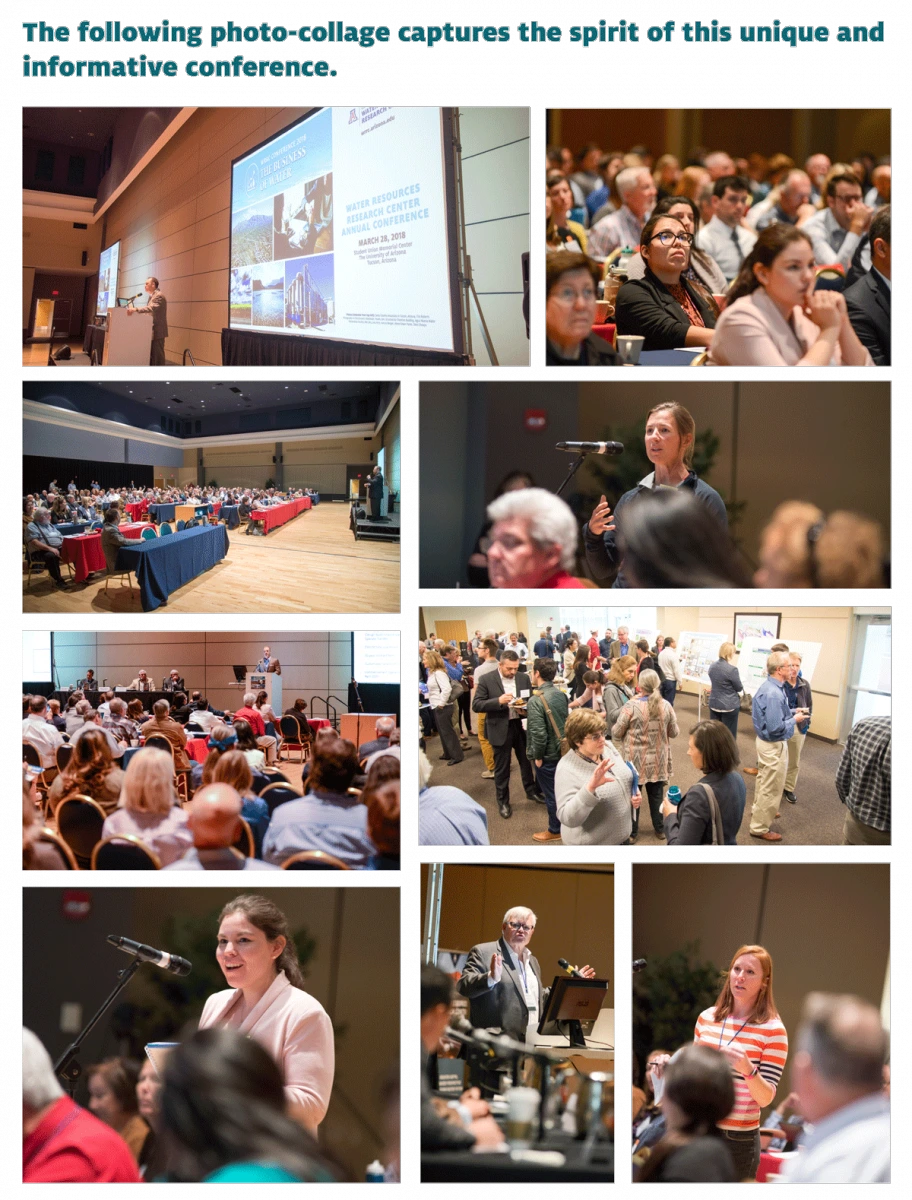by Susanna Eden, WRRC
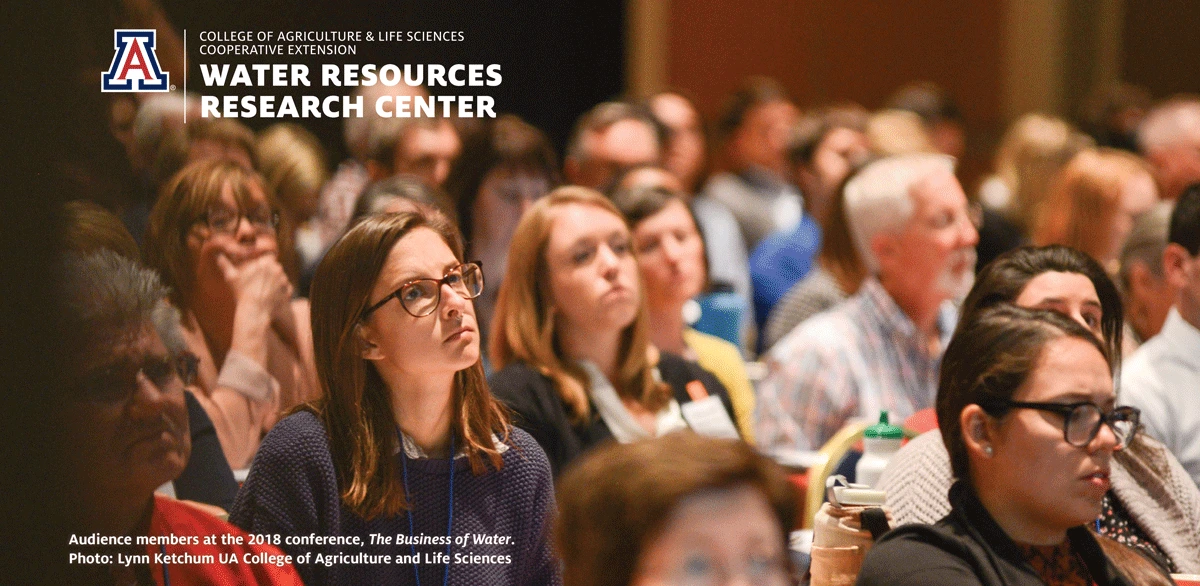
The Business of Water is an unusual topic for a water conference, despite the fact that business considerations enter into most, if not all, decisions affecting water resources. What exactly is the business of water and what aspects of the topic should a conference address? The Water Resources Research Center’s 2018 Annual Conference answered these questions broadly. As might be expected, many talks focused on funding and financing issues, but others looked at collaborations, exchanges, economic justice issues, environmental values, and social forces that influence or are influenced by business practices.
The three keynote talks reflected this comprehensive approach. According to Ian Lyle, Executive Vice President,National Water Resources Association, the prospect for federal funding of water projects looks uncertain, largely because of political uncertainties and partisan positioning. Without federal funding, local and regional project sponsors must find innovative financing strategies. The panel on Public-Private Partnerships (P3s) picked up this theme with several case studies—San Antonio, San Diego, and Pima County—where different public-private arrangements were employed to suit the needs of different jurisdictions for different kinds of projects. The key to designing these P3 arrangements was in balancing the risks and costs among the parties.

Stephen R. Lewis, Governor of the Gila River Indian Community, approached the business of water from a different angle. He wants the Community’s actions to serve as a “moral compass” to guide policy making on matters of economic, social, and cultural significance. He noted that with the water committed in their 2004 water settlement, the Community is in a position to achieve their long-term goals for reviving their agricultural heritage and the life of the Gila River. At the same time, they can contribute to Arizona’s immediate needs to shore up Lake Mead and to secure water storage credits for future growth.
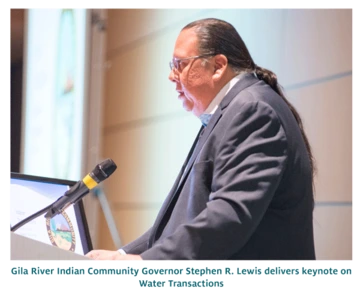
The idea of “moral compass” was at the center of the following discussion of water transactions. A guide is needed to navigate the complexities involved in moving water because nearly all such actions have an impact beyond the parties to the transaction, not just economically, but also in terms of intangible values and the vitality of environmental systems. In Arizona, where pressures for change encounter an inflexible legal system, water transactions are difficult but inevitable. Fortunately, new approaches are developing beyond the relatively simple exchange of money for water. Creativity and collaboration are the keys, as demonstrated by the City of Phoenix in its exchanges with the other municipalities to achieve mutual goals efficiently.
The third keynote was presented by the Director of the Arizona Department of Water Resources, Tom Buschatske, who described the challenges the state is facing as it looks into the future. These challenges result from a concatenation of historical development, legal inflexibility, drought, and disagreements about the best path forward. Despite its many water management successes, the state must continue negotiation with neighbors, collaboration among stakeholders, and engagement with the public. The ability of Arizona to attract and support the businesses that turn the economic engine depends to a large extent on approaching its water challenges with a unified front.
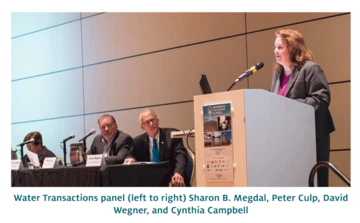
The importance of Mexico to the business of water in Arizona was underscored in Director Buschatske’s remarks, especially the opportunities provided by the recent agreement with Mexico—Minute 323. Cross-border cooperation was a theme of the luncheon discussion, which focused on the border region. The conversation, moderated by WRRC Director Sharon Megdal, featured Salvador López-Córdova, NAD (North American Development) Bank’s Chief Environmental Officer, and Edward Drusina, the U.S. Commissioner for the International Boundary and Water Commission. Although they have very different histories and responsibilities, both the institutions the discussants represent work to improve water and wastewater services within the border region. Through the efforts of NADBank, the gap in meeting basic water needs has been declining, but there are still gaps in collection and treatment of wastewater. The IBWC, with responsibilities dictated by the 1944 Treaty between Mexico and the United States for the Utilization of Waters of the Colorado and Tijuana Rivers and of the Rio Grande, operates three international wastewater treatment plants and monitors and measures river water deliveries from one country to the other.
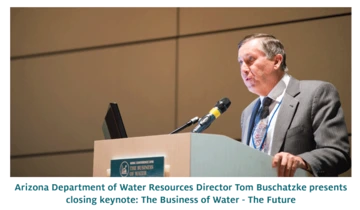
After lunch, the afternoon panels took up issues relating to water in the environment—the collaborations that are preserving or restoring natural water systems and the opportunities healthy natural water systems provide for economic development. Companies are beginning to recognize their vulnerability to disruptions from environmental degradation and are trying to manage the risk. Corporations care about how is their customer base is affected and often are moved by social perceptions. A few companies are building water stewardship into their business plans. Often their actions involve collaboration with NGOs such as The Nature Conservancy, which puts corporate funding to work on conservation and restoration projects. Philanthropic organizations such as the Walton Family Foundation can tackle systemic problems relating to freshwater resources by working with other funders, NGOs, public entities, and businesses. A concerted effort is needed.
The panel exploring the links between water and economic opportunity presented the experiences of four very different communities: a large city (Phoenix) and a medium-size city (Tucson) on mostly dry rivers, a smaller city on the Colorado River (Yuma), and a small town on the
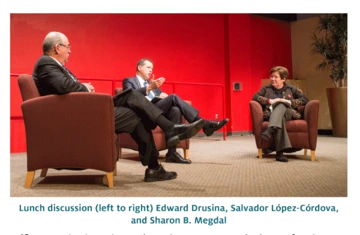
Verde River (Clarkdale). Despite their differences, these communities recognize that water vital to economy. Economic development in Phoenix is closely coordinated with water planning. Tucson is exploring the potential of a Santa Cruz River Heritage Project to bring high-quality recycled water to the downtown river, which could push the downtown renaissance to the next level. In Yuma, the National Heritage Area, a large river restoration effort, created a framework for economic development. In the Clarkdale area, collaborative efforts over many years turned the “dirty Verde” into an ecotourism destination.
A poster session displaying the latest in water research rounded out the conference’s inclusive approach to the business of water. Scientific and technological advances underpin business development and economic progress. I suggest: The poster session featured 21 posters presenting work on solving an astounding range of water issues. Student poster contest winners were selected by a panel of expert judges. The winning posters reflect the variety of topics covered during the conference. First prize went to “Using Water Isotopes and Solute Chemistry to Investigate the Hydrology of Surface Water in the Cienega Creek Watershed” (Erin Gray). Second and third place winners were “Accumulation of Heavy Metals in Aquaponic Systems and Effects on Bacterial Antibiotic Resistance” (Hany Almotairy) and “Water Leachability of Inorganic N and P from Turfgrass Leaf Tissue” (Emily Hyde).
All photos by Lynn Ketchum, University of Arizona College of Agriculture and Life Sciences
